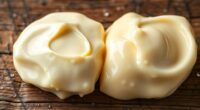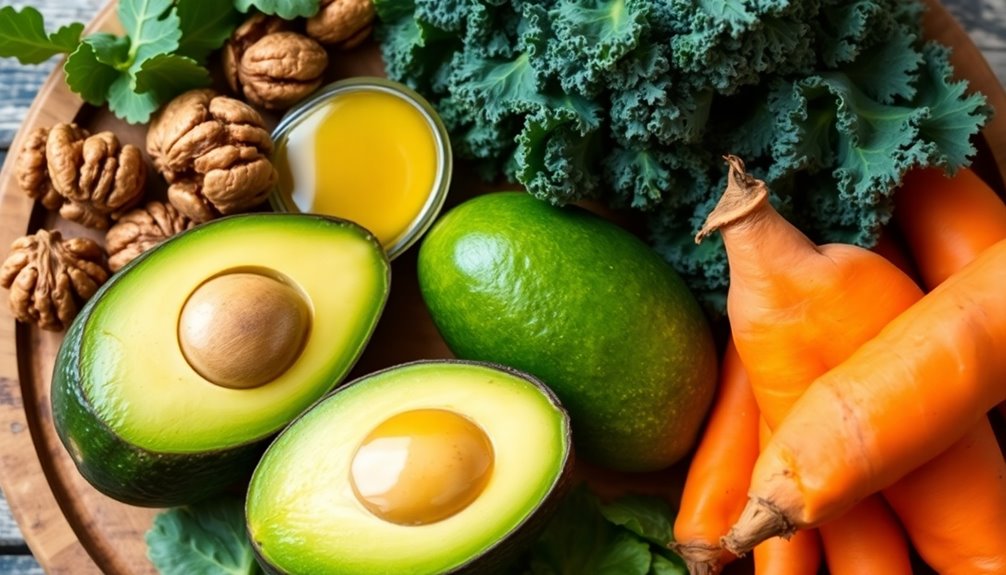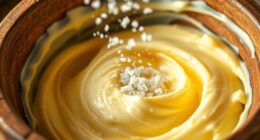Recent meta-analyses indicate that moderate butter consumption can modestly raise your HDL, the “good” cholesterol. It challenges the old myth that butter markedly increases cardiovascular risk. While butter’s saturated fats may boost HDL slightly, its overall impact depends on your diet and lifestyle. If you want to understand how this fits into heart health and how butter compares to other fats, keep exploring the latest research for a clearer picture.
Key Takeaways
- Recent meta-analyses indicate moderate butter intake may slightly increase HDL (“good” cholesterol) levels.
- Butter’s saturated fats can modestly boost HDL without significantly raising LDL (“bad” cholesterol).
- Variations in butter quality and dairy farming practices influence its impact on HDL levels.
- The overall effect on HDL is small and depends on the context of an individual’s diet.
- Current evidence suggests butter can be included in a balanced diet without negatively affecting HDL.
Understanding HDL Cholesterol and Its Role in Heart Health

Understanding HDL cholesterol is essential because it plays a crucial role in protecting your heart. HDL helps remove excess cholesterol from your bloodstream, supporting healthy lipid metabolism. Your body’s process of cholesterol synthesis produces both LDL and HDL particles, balancing your overall cholesterol levels. HDL acts as a scavenger, collecting cholesterol from arteries and transporting it back to the liver for disposal or reuse. This process reduces the risk of plaque buildup, lowering your chances of heart disease. By maintaining good HDL levels, you’re actively supporting your cardiovascular health. Lifestyle choices, such as diet and exercise, influence HDL’s effectiveness in lipid metabolism. Recognizing HDL’s protective role emphasizes the importance of managing cholesterol levels for a healthier heart.
The Composition of Butter and Its Nutritional Profile

Butter is a rich, dairy-based fat that has been used in cooking and baking for centuries. Its composition results from dairy processing, where cream is churned to separate butterfat from buttermilk. Nutritional labeling reveals that butter mainly provides saturated fats, along with small amounts of monounsaturated and polyunsaturated fats. It also contains vitamin A, vitamin D, and trace minerals. The fat profile influences how your body processes it, and understanding this helps you make informed choices. Since butter is a natural product, its nutritional profile can vary slightly depending on the source and processing methods. Knowing the detailed composition helps you balance butter’s use within your diet, especially when considering its effects on cholesterol levels and overall heart health. Additionally, the fatty acid composition of butter impacts its influence on cardiovascular health and cholesterol levels.
Overview of Recent Research on Dietary Fats and HDL Levels

Recent studies show that butter’s lipid profile can influence HDL levels, but results vary depending on the research design. You’ll find that meta-analyses help synthesize these findings, providing clearer insights into how dietary fats affect HDL. Understanding these studies can guide you in making informed dietary choices and updating guidelines accordingly. Additionally, considering the impact of lifestyle factors such as remote work productivity can contribute to overall cardiovascular health.
Butter’s Lipid Profile Impact
While dietary fats have long been scrutinized for their effects on cholesterol levels, recent research highlights how butter specifically influences HDL, or “good” cholesterol. Studies suggest that butter’s unique lipid profile may boost HDL levels, possibly due to its natural butter flavor and nutrients derived from dairy farming. This impact varies depending on butter quality and consumption patterns. Some research indicates that moderate butter intake can improve HDL without raising LDL, challenging outdated views. To illustrate, consider the following factors:
| Factor | Effect on HDL |
|---|---|
| Butter flavor | Enhances palatability, encourages regular use |
| Dairy farming practices | Affect fat composition in butter |
| Saturated fats | Potentially raise or stabilize HDL |
| Processing methods | Influence nutrient retention |
| Consumption amount | Determines overall impact |
Additionally, the nutrient composition of butter, including its specific fatty acids, also plays a role in its effect on HDL levels.
Meta-Analysis Methodology
Meta-analyses synthesize data from multiple studies to identify overall trends and assess the reliability of findings related to dietary fats and HDL levels. In recent research, scientists analyze numerous trials, comparing how butter flavor and other fats influence HDL. They carefully select studies from various sources, often considering differences in dairy farming practices that affect butter composition. The methodology involves statistical tools that evaluate the consistency and strength of the evidence, accounting for potential biases. By pooling results, researchers can determine if butter truly raises “good” HDL cholesterol or if previous findings were affected by study design variations. This approach guarantees that conclusions aren’t based on isolated data but reflect an aggregated understanding of dietary fats’ impact on HDL, providing a solid foundation for future dietary recommendations.
Implications for Dietary Guidelines
Emerging research on dietary fats and HDL levels is shaping how guidelines recommend balancing fat intake for heart health. Since butter holds significant cultural importance in many regions, its role in diet guidelines is complex. Recent findings suggest that moderate butter consumption may not adversely affect HDL levels as once thought, which could influence future recommendations. Understanding butter’s production methods, from traditional churns to modern processing, helps clarify its nutritional profile. As science evolves, dietary guidelines may shift away from blanket restrictions on butter, emphasizing overall dietary patterns instead. This nuanced approach encourages you to contemplate butter’s place within a balanced diet, recognizing that cultural habits and food preparation methods matter when assessing its health impacts.
Methodology of the Latest Meta-Analysis on Butter Consumption

The methodology of the latest meta-analysis on butter consumption involves a systematic approach to identify, select, and analyze relevant studies. You start by searching multiple databases for research on butter intake, HDL levels, and dairy farming practices. Studies are screened based on strict inclusion criteria, such as sample size, study design, and duration. To guarantee consistency, researchers focus on studies that detail butter flavor effects and differentiate between butter types, considering dairy farming methods. Data extraction follows a standardized process, capturing information on participants, butter consumption, and HDL outcomes. Quality assessments are performed to evaluate bias and validity. This rigorous process helps ensure the meta-analysis provides reliable insights into butter’s impact on HDL, reflecting current research standards and minimizing confounding factors. Additionally, researchers may incorporate numerology insights to interpret the significance of patterns in the data, further enriching the analysis.
Key Findings: Does Butter Significantly Influence HDL Levels?

Recent research synthesizing multiple studies provides valuable insights into whether butter intake truly impacts HDL cholesterol levels. The findings suggest that moderate butter consumption may offer some benefits for HDL, often called the “good” cholesterol. However, these results challenge common cholesterol myths that butter markedly raises overall cardiovascular risk. Instead, the latest meta-analysis indicates that butter’s influence on HDL levels is modest and context-dependent, with some studies showing slight increases. While butter might contribute to improved HDL, it shouldn’t be viewed as a standalone health booster. Overall, the evidence points to a nuanced understanding: butter benefits are possible when included as part of a balanced diet, but it’s not a magic bullet for HDL improvement. Additionally, considering the comprehensive effects of dietary fats can help better assess butter’s role in heart health. This clarifies the ongoing debate about butter’s role in heart health.
Comparing Butter to Other Dietary Fats and Their Effects on HDL

When comparing butter to other dietary fats, it’s important to recognize that different fats impact HDL levels in varied ways. Butter’s saturated content tends to raise HDL modestly, but the overall effect depends on what you replace it with. Replacing butter with healthier fats can improve your lipid profile, while substituting with trans fats worsens it. Here’s a quick comparison:
| Fat Type | Effect on HDL | Key Point |
|---|---|---|
| Butter (saturated) | Slight HDL increase | Moderate impact, context matters |
| Olive oil | Raises HDL | Heart-healthy monounsaturated |
| Canola oil | Slight HDL boost | Good alternative to butter |
| Trans fats | Lowers HDL | Should be avoided |
| Coconut oil | Neutral to slight increase | Saturated but different profile |
Understanding fat replacement impacts helps you make better choices for heart health.
Practical Implications for Dietary Choices and Heart Disease Prevention

Making informed dietary choices can considerably impact your heart health. Clear guidance on fats and cholesterol helps you manage your risk of heart disease effectively. By understanding these connections, you can choose foods that support better HDL levels and overall well-being.
Dietary Recommendations Clarity
Clarifying dietary recommendations is essential for helping you make informed choices that support heart health. When it comes to butter, understanding its role can be confusing due to its butter flavor and culinary uses. Clear guidance helps you decide whether to include small amounts of butter in your diet or choose alternatives. It’s important to recognize that butter’s saturated fat content can influence cholesterol levels, but recent research suggests the impact on HDL may be less straightforward. Practical advice should focus on moderation and balanced eating patterns rather than strict restrictions. Knowing how to incorporate butter flavor into your meals responsibly allows you to enjoy your favorite dishes without compromising heart health. Dietary patterns play a crucial role in overall cardiovascular well-being. Clear, practical recommendations empower you to make smarter, more confident dietary choices.
Heart Disease Risk Management
Effective management of heart disease risk hinges on making informed dietary choices that prioritize your cardiovascular health. To do so, consider these practical tips:
- Recognize that butter allergies are rare, and for most, butter can be part of a balanced diet.
- Understand that the saturated fat myth has been challenged; recent studies suggest moderate consumption doesn’t considerably raise risk.
- Focus on replacing saturated fats with healthier options like nuts, seeds, and plant oils for better heart health.
- Incorporating AI-driven insights can further help tailor dietary recommendations to individual needs and improve overall heart health strategies.
Future Directions in Research on Butter, Fats, and Cholesterol

Future research on butter, fats, and cholesterol is poised to explore more nuanced understandings of their health impacts, especially as new analytical techniques emerge. You’ll see studies examining how butter flavor influences consumer perceptions and consumption patterns, potentially affecting risk factors. Additionally, researchers will explore into fat digestion processes, investigating how different fats are broken down and absorbed, which impacts their effects on cholesterol levels. Advancements in imaging and biochemical analysis will help clarify how specific fatty acids interact with metabolic pathways. This deeper insight could lead to personalized dietary recommendations and improved public health strategies. As science progresses, you’ll gain a clearer picture of how butter and other fats influence cholesterol and overall heart health, guiding more informed choices. Understanding fat digestion will be crucial in developing targeted nutritional guidelines.
Frequently Asked Questions
Does Butter Impact Other Types of Cholesterol Besides HDL?
You might wonder if butter impacts other types of cholesterol besides HDL. Research shows that butter can raise LDL cholesterol, which is often called “bad” cholesterol, and may also increase triglycerides in some individuals. While butter can contribute to higher triglyceride levels, its effect on LDL is more consistent. It’s important to take into account these impacts when managing your overall cholesterol levels and making dietary choices.
Are There Specific Populations That Benefit More From Butter Consumption?
You might find that certain population groups benefit more from butter consumption, especially when genetic factors influence how your body processes fats. For example, individuals with specific genetic profiles may experience better HDL responses or less impact on LDL levels. It’s important to contemplate your personal health and family history, as these factors can determine whether butter fits into your diet comfortably and safely.
How Does Butter Consumption Compare to Plant-Based Fats Regarding HDL?
Did you know that plant-based fats are linked to higher HDL cholesterol levels compared to butter? When comparing butter vs plant-based fats, research shows plant oils like olive or canola markedly boost HDL, while butter’s impact is more modest. You’ll benefit more from incorporating plant fats into your diet if you’re aiming to improve your HDL cholesterol impact, as they offer healthier fats without raising LDL levels.
What Are the Long-Term Effects of Regular Butter Intake on Heart Health?
You might wonder about the long-term effects of regular butter intake on heart health. Consuming butter consistently can increase saturated fat levels, which may raise your risk of cardiovascular issues over time. While small amounts might not cause harm, high or frequent consumption could negatively impact your heart health. To protect your heart, consider balancing butter with healthier fats and maintaining a nutritious diet.
Can Butter Be Included in a Heart-Healthy Diet Without Increasing Risk?
Imagine enjoying butter in your diet without risking your heart health. Recent research shows that moderate dairy fat intake, including butter, might not harm your cardiovascular system as once thought. While saturated fat is often linked to increased risk, the latest meta-analysis suggests butter can be included in a heart-healthy diet if consumed mindfully. Balance and moderation are key to reaping its flavor without compromising your health.
Conclusion
So, next time you reach for butter, don’t expect it to turn you into a heart-healthy superhero overnight. While it might nudge your HDL up slightly, it’s hardly a golden ticket to better heart health. Instead, enjoy it in moderation—because, let’s face it, even the “good” fats can’t save you from a diet of donuts and denial. Balance and common sense still reign supreme in the cholesterol game.









